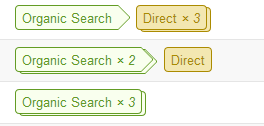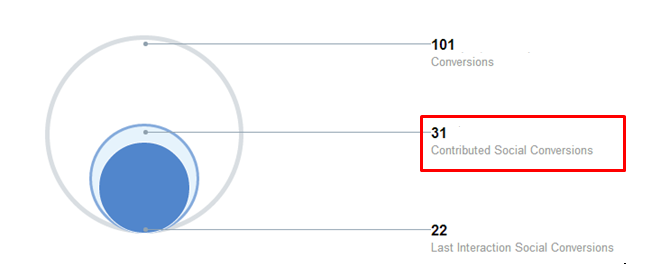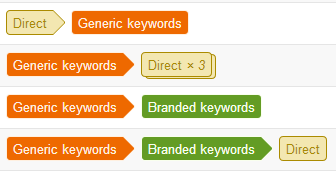 The average consumer goes through more than five touch points with an ecommerce business before they convert. This number is trending upward, as companies and customers continue to interact across a greater number of platforms. B2B companies, with often greater price points and a longer buying cycle, may find the number of interactions with prospects prior to conversion even higher.
The average consumer goes through more than five touch points with an ecommerce business before they convert. This number is trending upward, as companies and customers continue to interact across a greater number of platforms. B2B companies, with often greater price points and a longer buying cycle, may find the number of interactions with prospects prior to conversion even higher.
Good content marketers know that integrated, consistent messaging is critical across multiple digital platforms. It allows us to connect with our customers how – and when – they expect to connect with us.
With so many touch points between first contact and conversion, how are companies able to break through all of the data within analytics? We need to determine not only which channels are most effective, but also how to customize marketing activities to the behavior and preferences of the audience in that channel, at that point in their decision.
For example, a TopRank ecommerce client recently lamented the portion of conversions that could be attributed to direct search or branded search. According to their interpretation of the data available to them, the majority of their conversions came from direct traffic. Why then, they asked, are we dedicating resources to social media and SEO when their only purpose seems to be building brand awareness?
It’s a valid question; companies can’t afford to sink budget into underperforming channels or tactics. However, a deep dive into their Google Analytics data showed us that:
- 75% of conversions are assisted (or included multiple digital touch points).
- About 50% of conversions can be attributed directly to organic traffic.
- 80% of conversion paths included organic search as a touch point.

In fact, their second most popular conversion path looked like this:
Arrives via Organic search (usually non-branded) > User leaves the site (probably to shop around) > User Returns via Direct Visit
For this particular client, SEO is absolutely a critical part of their mix! It would have been a grave mistake to discount search optimization altogether. In the mobile & social age, businesses must use Analytics data from multi-channel conversions to shape their marketing mix, as this ecommerce client did. That deeper understanding of your customers and prospects will help you make business decisions that make sense, founded in the most recent, relevant data available.
Let’s explore 3 ways to use multi-channel analytics data to shape your marketing strategy.
#1: Review social as part of assisted conversion strategy
Tracking ROI on social can be tricky; for many businesses, it’s less likely to be considered a referring source and more likely to be used as a means for amplifying content or interacting with customers and prospects directly. However, reviewing social as part of your multi-channel funnel will give you a much better idea of how your social visitors are interacting on the site.
To illustrate this, we’ll use the real-world example of relatively new fashion brand and TopRank client, who boasted higher-than-average traffic from social networks. Based on their analytics, we knew social traffic only contributed to 15% of total visits, yet the average social visitor spent 4x as long on the site and visited more pages.

Social as last click represented only a small portion of converting visitors, but social actually contributed to well over 30% of transactions. We knew for this business, social visitors were more apt to buy than the average user. Additional sales-oriented content to their social audience helped their social fans feel more valued and connected to the brand.
The takeaway: Consider conversions beyond a purchase or Contact Us and you may find social visitors are more likely to download a white paper or watch a video than the average user. This information not only can help you refine your marketing mix, it can also shape your content plan by indicating the action your social visitors are most apt to take.
#2 Customize Multi-Channel Reporting
Organic search, direct and referral sources are automatically detected by multi-channel reporting. Going above and beyond to track emails campaigns, PPC, and branded vs. non-branded keyword traffic requires some additional setup, but is well worth your time.

For example, distinguishing between branded and non-branded keyword traffic is a must for businesses measuring the impact of their SEO efforts. In our first example, an ecommerce client believed all conversions were coming from direct and branded search. However, filtering branded versus non-branded traffic allowed the client to not only see the impact of organic search as a whole, but also how non-branded searches were often the first touch leading to subsequent branded searches or direct visits.

The takeaway: Create a custom channel grouping leveraging unique labels for platforms. In addition to rounding out your marketing mix, customized grouping will allow you to mine out more data from the detected channels.
#3 Integrate for Advanced Attribution Modeling
The free version of Google Analytics is only going to track multichannel conversions over the course of 30 days. This is great for businesses with shorter buying cycles, but can prove problematic for products or services with a buying cycle longer than 1 month.
For businesses with longer buying cycles, or those looking to do more advanced attribution modeling, passing an anonymous Visitor ID along to the user to track behavior via integration with a CRM or Marketing Automation platform is key.
The takeaway: Don’t remove Social Media or display ads from your marketing mix just because you don’t see those sources converting is your multi-channel report. Instead, integrate with your CRM or marketing automation software for a complete picture. It’s likely those touch points are still contributing to increased awareness in earlier stages of the buying cycle.
As marketing mixes become more complex, data grows, and we push more toward integrated marketing, it can be challenging to connect performance to specific tactics. It’s now more important than ever, though. Customizing and diving into multi-channel conversion report is a great step toward increasing your brand’s awareness of your greatest performers and potential. Without this clarity and accurate insight, business decisions are really only best guesses based on faulty logic.
Is your business already using multi-channel reporting or more advanced attribution modeling? Share your thoughts in the comments.
Image at top from Shutterstock.com.


